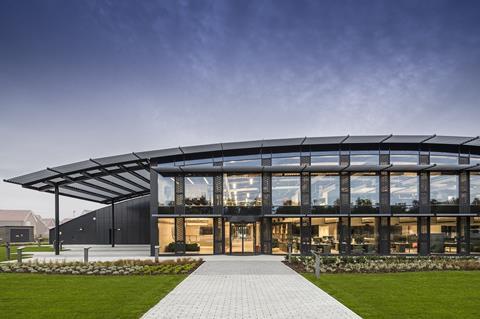Ridge & Partners is one of the fastest-growing large firms in Building’s Top 150 Consultants list out this week. Senior partner Adrian O’Hickey explains more about the firm’s growth plans

With all the market uncertainty of recent years, including inflation, supply chain pressures and political turmoil, it is perhaps wise – particularly if you are a consultant looking to grow in the construction industry – not to put all your eggs in to one basket .
Better, perhaps, to ensure that revenue is generated from a wide range of sectors, disciplines and activities.
This is an approach that appears to be working for Ridge & Partners, a £120m-turnover business that is taking a multidisciplinary approach to the extreme while posting impressive growth figures.
The firm, which has 12 offices across the UK, grew its annual fee income by 30% to £113m last year, the biggest percentage rise among the largest 20 firms in Building’s latest Top 150 Consultants list, which is published later this week. This comes off the back of growth of 26% the previous year.
Building sat down with Ridge’s managing partner Adrian O’Hickey at the firm’s recently revamped office in Southwark, south London, to discuss the firm’s approach. O’Hickey, whose voice retains a trace of a North-east accent – he grew up in Darlington before moving to Oxford in his 20s – launches straight into what he sees as Ridge’s unique selling point.
Multiple disciplines and sectors
“The USP of Ridge is the multidisciplinary aspect,” he says. “If you look at Building magazine’s Top 150, where we sit across our core disciplines is quite strong in every one of those tables.”
Ridge indeed is fairly prominent in all of Building’s latest Top 150 Consultant tables, which are published this month and rank firms by UK fee income. Ridge is 18th in the main Top 150 table, 8th in the surveyors list, 13th in both the project managers and engineers rankings and 18th in the architects’ list.
“In relative terms as an organisation, we are quite small compared to some of the largest consultancies, yet the strength we have across all those disciplines enables us to provide agile advice to clients,” O’Hickey says.
The spread of activity can be seen in two pie charts that O’Hickey was proud to show Building. The firm’s £120m turnover from 2023 is spread across 16 sectors and 18 disciplines, with no area above 16% in the former or 18% in the later. (see graph below).

When O’Hickey joined Ridge in the 1980s, he says it was predominantly involved in quantity surveying and building surveying but has over time evolved the “skill and depth” of many more disciplines. “It’s not now a practice dominated by one aspect. We sell great multidisciplinary offerings where clients come to us as a one-stop shop,” he says.
Each of the teams working in different areas can work independently, Hickey says, “building great relationships with other consultants and clients even when we are providing a single source”.
Growth plans
Ultimately, O’Hickey believes that having so many disciplines and sectors under one roof makes it easier to provide a better service.
“I came up the ranks through quantity surveying, but just knowing you can come back and talk to an engineer or an architect or project manager to test what the opportunities are enables each individual to have more rounded knowledge of the project or solutions they are trying to find,” he says.
Ridge’s multi-disciplinary strength has been a factor in the firm’s high level of repeat business. Around 80-85% of business is from repeat clients – possibly, Hickey suggests, because Ridge “isn’t just trying to sell one thing”.
“What we’re trying to do is find the optimum solution for that client,” he says, stressing he is happy to work with other consultants if needed to achieve this.
With a bank of repeat clients and substantial performance in many disciplines and sectors, you might expect O’Hickey to be bullish about the firm’s future growth prospects. He is however coy at first about stating a growth goal.
Growth for us is about enabling people to develop their careers with us and if you get great people and great clients working together to do some really high quality work, we will get opportunities
“While we do have numbers in our minds, what we don’t have is a target to get to ‘x’ or ‘y’ by a certain period of time…. Growth for us is about enabling people to develop their careers with us and, if you get great people and great clients working together to do some really high quality work, we will get opportunities.”
When pushed however, O’Hickey says that Ridge has “an expectation” of turnover growth of more than 10% each year. So where will this growth come from?
IN NUMBERS: Ridge & Partners
£113m UK Fee Income 2023*
£120m turnover 2023
1,210 headcount
12 Offices
£17.3m pre-tax profit 2022**
*Figure supplied to Building by Ridge
**Figure taken from most recent published accounts, for the 2022 calendar year
He describes defence, which currently accounts for around 7 per cent of Ridge’s income, as an area where there is a “significant opportunity to grow further”.
While unsure about the extent to which he can talk about specific projects that Ridge is work on, giving the strict security regulations, Ridge is one of several consultancies to deliver multidisciplinary services to the Crown Commercial Services framework RM165 for defence.
“We’ve always had a track record working with the foreign office,” O’Hickey says. “We do work in defence right from the government to key suppliers, such as Boeing and work relating to facilities. Plus the stuff I know I can’t talk about,” he adds with a slight smile.
Another growth area he is able to discuss more freely is life sciences. Ridge is working on the new £1bn Ellison Institute of Technology campus in Oxford. The research and development facility is being designed by Foster + Partners, with Laing O’Rourke acting as the lead contractor.
“We are doing cost management and project management, as well as providing support functions and other design elements – it’s a fantastic project,” O’Hickey beams.

While Ridge is targeting defence, life sciences and data centres as potential growth areas, are there sectors where the company is seeing a slowdown?
O’Hickey does not precisely respond, he stresses that the firm’s public housing work, which accounts for 16% of turnover, is not just about the building of new homes, perhaps implying that the housebuilding market is uncertain.
“If you took our public sector residential offering, it’s not just new-build,” he emphasises. “There’s a lot of talk about the number of new homes, but there’s also an existing estate that needs to be maintained, particularly around some of the issues in tall buildings.”
He agrees that the regulatory pressure on the social housing sector to improve building safety and fix issues such as damp and mould represents an opportunity for the firm. While securing repeat business through multidisciplinary strength is one tactic to grow, another concerns acquisitions – and Ridge has made quite a few in recent years.
Acquisitions
Last November, in an attempt to strengthen its data centre activity, it acquired £5.5m-turnover Concert, a London-based project management and cost consultancy business.
The firm’s data centre clients include Ark Data Centres, Colt DCS and Green Mountain while clients in the commercial sector include JP Morgan and Nuveen.
We have a track record of doing acquisitions which are relatively small - so they don’t change the look and feel of Ridge- where they might add a specific skillset or a geography
This came off the back of the acquisition of £3.5m-turnover project manager and QS Projex Building Solutions for an undisclosed sum in 2021, and structural, civil engineering and sustainability consultancy Scott Hughes Design in 2020.
“We have a track record of doing acquisitions which are relatively small – so they don’t change the look and feel of Ridge – where they might add a specific skillset or a geography,” he says. Once a firm has been acquired for a specific purpose, Ridge can then “add other disciplines in” to grow it.
He says Manchester firm CrE8 Management, which was acquired as a project manager, has quadrupled since Ridge bought it in 2015.
Ridge’s opportunity-led approach to acquisition is echoed in its strategy around offices. The firm is registered to an address in Oxford and has 12 offices in total dotted around the country.
Despite carrying out work overseas, in areas such as motorsport, dispute resolution or work for the Foreign Office, the firm currently does not have a base overseas.

“We are quite agile in our thinking. If we found an opportunity or thought there was a strong opportunity, we would follow it,” O’Hickey stresses, pointing out the firm briefly had an office in China, albeit for a project-specific purpose. The firm was based in the country when it was working on the full masterplan and architecture design for the 52-hectare Zhejiang motorsport circuit a few years ago.
Investing in people
While securing repeat business and looking to acquisitions and overseas business can all help Ridge to grow, the area that O’Hickey seems most passionate about is growing the workforce’s skills and development. The firm has recently launched a new career development framework for staff and introduced employee-led cycles of conversations between employees and managers.
Last year Ridge launched the Future Talent Team to “lead on fostering career growth and initiatives to reach a diverse range of talented individuals”. It has revamped its equality, diversity and inclusion policies, and introduced a new Head of ED&I in addition to an employee experience and wellbeing lead.
As a result of this blizzard of activity, Ridge has been shortlisted in the good employer category in this year’s Building Awards.
For O’Hickey, Ridge has always been an employer that offered learning and progression – a key reason why he has stayed at the firm for 38 years. This was initially because its small size meant more opportunity for varied work and learning from others.
Ridge might now be a £120m-turnover business with 1,200 employees, but the sense given is that the managing partner wants to preserve what he liked about the firm all those years ago.

“When I joined Ridge, I joined as a year-out student, and we had 40 people,” he says. “A lot of my friends at university went to other [larger] practices and their job roles were quite narrow. But I got this diversity in terms of different projects and opportunities to learn, along with a relationship with the leadership team that embedded knowledge.
“I can remember very early on, sort of being quite energised by the variety and opportunities of projects that you could work on.”
Ridge’s internal strategy seems fairly clear, but what about the wider prospects for construction? Building’s Top 150 Consultants survey suggests rising optimism about trading conditions, so have we passed the bottom of the market?
The new government
O’Hickey reckons that things might start to improve in the third or fourth quarter of the financial year, but firms have a judgment call to make over when to invest and take risk.
“We’ve obviously got the new government, we have got a reduction in inflation, and we can assume interest rates are going to come down,” he says. “We can assume viability will improve in certain aspects and yet, at the moment, right here, right now, a lot of people are still on holiday.
“In quarters three and four, people will be back at their desks, the economic environment should hopefully continue to improve, and viability of commercial projects will continue to improve… So our sense of it is that we have hit the bottom and now we can go forward.”
I’m not sure we’ve got that clarity at the moment as to where they [ministers] are going to focus
Interestingly, O’Hickey suspects there will be “less predictability” about investment under the new Labour government than one might have expected.
“I think historically, where you’ve changed from Conservative to Labour, within the construction industry there was a strong sense that there would be a significant investment in education or health or whatever,” he says. “I’m not sure we’ve got that clarity at the moment as to where they are going to focus.”
He also warns that construction activity could be delayed if the government is “too harsh on wealth creation … I see government as an enabler,” he says, adding that if ministers have “real clarity of thought and clarity of spend about the infrastructure that’s going to go in”, then private investment will follow.
When it comes to planning, O’Hickey wants more flexibility, saying that constraints around the use of sites and planning rules can often lead to a situation where a final scheme is “probably not as good” as what could have been delivered.
“If you’re in the commercial world, so if you are working for Ridge, and you’re trying to find a solution for a client, you want that agility, you want that pragmatism. You want to find the best solution,” he says.
Asked whether Labour’s draft National Planning Policy Framework might improve things, he simply says “no” and adds that a more pragmatic and flexible approach is needed.
On Labour’s proposal to bring back mandatory housing targets, O’Hickey cautions that “you’ve still got a community that you need to embed these things into”, so you have to encourage people rather than imposing development on them.
His scepticism is perhaps understandable. After all, there have been many governments and many planning shake-ups since a fresh-faced O’Hickey joined Ridge on a gap-year placement 38 years ago.

O’Hickey recalls how he wanted to follow his father, who was a QS, into construction but also wanted some office work in addition to being on site. He wanted to move away from Darlington to live in a city – Manchester or Newcastle were his first choices – but saw an advertisement for a gap-year opportunity at Ridge in Oxford.
“It said they would pay my train fare to go to the interview,” he says, joking that “no self-respecting student” could turn that down. “And then I got to the point where I was offered the job, and I took it because I thought, it’s only a year… And here I am 38 years later.”
Barring brief envy of a friend who moved to Australia, O’Hickey says he has never been tempted to move, citing – again – the variety of work Ridge offers. But is the danger with being multidisciplinary that Ridge becomes a jack of all trades?
“We haven’t, because we have got that strength in depth and we have now got the size and resilience to add value,” he says. “For me that’s the important thing.
“When you are trying to work with a client, or work with other consultants or work other contractors, if you are not adding value, then what’s the point?”
O’Hickey, then, sees Ridge’s diversified business model not as a way of merely spreading risk in a difficult environment but as a way of improving the overall level of service to clients, while at the same time giving staff opportunities to develop. Thus far it appears to be a pretty successful forumla for growth.
Top 150 Consultants 2024

Building will be publishing Top 150 Consultants 2024 survey findings throughout this week, including pieces on hybrid working tomorrow and the use of artificial intelligence and machine learning tools on Wednesday.
On Friday we publish our full Top 150 Consultants list, which ranks companies by their UK fee income. In addition, we will publish separate tables for the Top 50 architects, engineers, project managers and surveyors.
Our exclusive analysis will dig in to the data and spotlight the firms that have posted impressive growth over the past year.
The survey will reveal insights into the biggest risks to consultants, areas of fee income, spending priorities, margins and staffing, along with commentary about the shifting trends in the industry.
Find out how consultants have ranked priorities for construction for Keir Starmer’s government.




























No comments yet